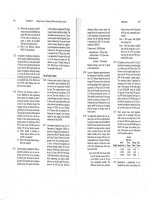Mc graw hill oxorn foote human labor and birth 6th edition 2013 retail ebook ke
Bạn đang xem bản rút gọn của tài liệu. Xem và tải ngay bản đầy đủ của tài liệu tại đây (13.18 MB, 801 trang )
Oxorn-Foote
HUMAN
LABOR
& BIRTH
Sixth Edition
Notice
Medicine is an ever-changing science. As new research and clinical experience
broaden our knowledge, changes in treatment and drug therapy are required. The
authors and the publisher of this work have checked with sources believed to be reliable in their efforts to provide information that is complete and generally in accord
with the standards accepted at the time of publication. However, in view of the possibility of human error or changes in medical sciences, neither the authors nor the
publisher nor any other party who has been involved in the preparation or publication of this work warrants that the information contained herein is in every respect
accurate or complete, and they disclaim all responsibility for any errors or omissions
or for the results obtained from use of the information contained in this work. Readers are encouraged to confirm the information contained herein with other sources.
For example and in particular, readers are advised to check the product information
sheet included in the package of each drug they plan to administer to be certain that
the information contained in this work is accurate and that changes have not been
made in the recommended dose or in the contraindications for administration. This
recommendation is of particular importance in connection with new or infrequently
used drugs.
Oxorn-Foote
HUMAN
LABOR
& BIRTH
Sixth Edition
Glenn D. Posner, MDCM, MEd, FRCSC
Associate Professor, The University of Ottawa
Department of Obstetrics and Gynecology
The Ottawa Hospital
Ottawa, Ontario, Canada
Jessica Dy, MD, MPH, FRCSC
Assistant Professor, The University of Ottawa
Department of Obstetrics and Gynecology
The Ottawa Hospital
Ottawa, Ontario, Canada
Amanda Black, MD, MPH, FRCSC
Associate Professor, The University of Ottawa
Department of Obstetrics and Gynecology
The Ottawa Hospital
Division of Pediatric Gynecology, Children’s Hospital of Eastern Ontario
Ottawa, Ontario, Canada
Griffith D. Jones, MBBS, MRCOG, FRCSC
Assistant Professor, The University of Ottawa
Medical Director, Obstetrics & Gynecology Ultrasound
Division of Maternal–Fetal Medicine
Department of Obstetrics and Gynecology
The Ottawa Hospital
Ottawa, Ontario, Canada
New York Chicago San Francisco Lisbon London Madrid Mexico City
Milan New Delhi San Juan Seoul Singapore Sydney Toronto
Copyright © 2013 by McGraw-Hill Education, LLC. All rights reserved. Except as permitted under the United
States Copyright Act of 1976, no part of this publication may be reproduced or distributed in any form or by any
means, or stored in a database or retrieval system, without the prior written permission of the publisher.
ISBN: 978-0-07-178023-0
MHID: 0-07-178023-8
The material in this eBook also appears in the print version of this title: ISBN: 978-0-07-174028-9,
MHID: 0-07-174028-7.
All trademarks are trademarks of their respective owners. Rather than put a trademark symbol after every
occurrence of a trademarked name, we use names in an editorial fashion only, and to the benefit of the trademark
owner, with no intention of infringement of the trademark. Where such designations appear in this book, they have
been printed with initial caps.
McGraw-Hill Education eBooks are available at special quantity discounts to use as premiums and sales
promotions, or for use in corporate training programs. To contact a representative please e-mail us at bulksales@
mcgraw-hill.com.
Previous edition copyright © 1986 by Appleton-Century-Crofts.
TERMS OF USE
This is a copyrighted work and McGraw-Hill Education, LLC. and its licensors reserve all rights in and to the
work. Use of this work is subject to these terms. Except as permitted under the Copyright Act of 1976 and
the right to store and retrieve one copy of the work, you may not decompile, disassemble, reverse engineer,
reproduce, modify, create derivative works based upon, transmit, distribute, disseminate, sell, publish or sublicense
the work or any part of it without McGraw-Hill Education’s prior consent. You may use the work for your own
noncommercial and personal use; any other use of the work is strictly prohibited. Your right to use the work may
be terminated if you fail to comply with these terms.
THE WORK IS PROVIDED “AS IS.” McGRAW-HILL EDUCATION AND ITS LICENSORS MAKE NO
GUARANTEES OR WARRANTIES AS TO THE ACCURACY, ADEQUACY OR COMPLETENESS OF
OR RESULTS TO BE OBTAINED FROM USING THE WORK, INCLUDING ANY INFORMATION THAT
CAN BE ACCESSED THROUGH THE WORK VIA HYPERLINK OR OTHERWISE, AND EXPRESSLY
DISCLAIM ANY WARRANTY, EXPRESS OR IMPLIED, INCLUDING BUT NOT LIMITED TO IMPLIED
WARRANTIES OF MERCHANTABILITY OR FITNESS FOR A PARTICULAR PURPOSE. McGraw-Hill
Education and its licensors do not warrant or guarantee that the functions contained in the work will meet your
requirements or that its operation will be uninterrupted or error free. Neither McGraw-Hill Education nor its
licensors shall be liable to you or anyone else for any inaccuracy, error or omission, regardless of cause, in the
work or for any damages resulting therefrom. McGraw-Hill Education has no responsibility for the content of
any information accessed through the work. Under no circumstances shall McGraw-Hill Education and/or its
licensors be liable for any indirect, incidental, special, punitive, consequential or similar damages that result from
the use of or inability to use the work, even if any of them has been advised of the possibility of such damages.
This limitation of liability shall apply to any claim or cause whatsoever whether such claim or cause arises in
contract, tort or otherwise.
DEDICATION
to Dr. Harry oxorn. We hope you’d be proud.
╇ Birth record of Dr. Griffith D. Jones. Dr. Foote played an even more important role in HIS history!
xvii
Part i: clinical Anatomy
1
1 Pelvis: Bones, Joints, and Ligaments
2 The Pelvic Floor
3 Perineum
3
9
15
4 Uterus and Vagina
5 Obstetric Pelvis
21
37
6 The Passenger: Fetus
53
7 Fetopelvic Relationships
65
8 Engagement, Synclitism, Asynclitism
Part ii: First Stage of Labor
9 Examination of the Patient
87
89
10 Normal Mechanisms of Labor
101
11 Clinical Course of Normal Labor
12 Fetal Health Surveillance in Labor
13 Induction of Labor
14 Labor Dystocia
77
119
143
173
193
15 Abnormal Cephalic Presentations
211
CONTENTS
Contributors xi
Preface xv
Acknowledgments
viii
Contents
Part III: Second Stage of Labor 263
16 The Second Stage of Labor 265
17 Operative Vaginal Delivery 283
18 Shoulder Dystocia 333
Part IV: Third Stage of Labor 351
19 Delivery of the Placenta, Retained
Placenta, and Placenta Accreta 353
20 Postpartum Hemorrhage 367
21 Episiotomy, Lacerations, Uterine Rupture, and
Inversion 389
Part V: Complicated Labor 431
22 Cesarean Section 433
23 Trial of Labor After Previous
Cesarean Section 457
24 Obesity in Pregnancy 463
25 Breech Presentation 471
26 Transverse Lie 515
27 Compound Presentations 523
28 The Umbilical Cord 529
29 Multiple Pregnancy 537
Contents
Part VI: Other Issues 567
30 Preterm Labor 569
31 Antepartum Hemorrhage 587
32 Maternal Complications in Labor 601
33 Labor in the Presence of Fetal Complications 635
34 Intrapartum Infections 647
35 Postterm Pregnancy 663
36 Obstetric Anesthesia and Analgesia 671
37 Intrapartum Imaging 695
38 The Puerperium 707
39 The Newborn Infant 725
Index 747
ix
This page intentionally left blank
Yaa Amankwah, MBcHB, FRcSc
Assistant Professor, The University of Ottawa
Department of Obstetrics and Gynecology
The Ottawa Hospital
Ottawa, Ontario, Canada [18]
Nadya Ben Fadel, MD, FAAP, FRcPc
Assistant Professor, The University of Ottawa
Division of Neonatology
Department of Pediatrics
Children’s Hospital of Eastern Ontario
Ottawa, Ontario, Canada [39]
Dan Boucher, MD, MSc
Clinical Fellow, The University of Ottawa
Department of Medicine
The Ottawa Hospital
Ottawa, Ontario, Canada [32]
Yvonne cargill, MD, FRcSc
Assistant Professor, The University of Ottawa
Division of Maternal–Fetal Medicine
Department of Obstetrics and Gynecology
The Ottawa Hospital
Ottawa, Ontario, Canada [28]
Darine el-chaar, MD, FRcSc
Clinical Fellow, The University of Toronto
Division of Maternal–Fetal Medicine
Department of Obstetrics and Gynecology
The Toronto University Health Network
Toronto, Ontario, Canada [12, 15, 22, 23, 24, 25]
Ramadan el Sugy, MD, FRcSc
Department of Obstetrics and Gynecology
William Osler Health System
Brampton, Ontario, Canada [21]
CONTRIBUTORS
Numbers in brackets refer to the chapter(s) written or co-written by
the contributor.
xii
Contributors
Karen Fung Kee Fung, MD, FRCSC, MHPE
Associate Professor, The University of Ottawa
Division of Maternal–Fetal Medicine
Department of Obstetrics and Gynecology
The Ottawa Hospital
Ottawa, Ontario, Canada [29]
Laura M. Gaudet, MD, MSc, FRCSC
Assistant Professor, Dalhousie University
Division of Maternal–Fetal Medicine
Department of Obstetrics & Gynecology
The Moncton Hospital, Horizon Health Network
Moncton, New Brunswick, Canada [33, 35]
Catherine Gallant, MD, FRCPC
Assistant Professor, The University of Ottawa
Department of Anesthesiology
The Ottawa Hospital
Ottawa, Ontario, Canada [36]
Andrée Gruslin, MD, FRCSC
Professor, The University of Ottawa
Division of Maternal–Fetal Medicine
Departments of Obstetrics and Gynecology & Cellular and Molecular Medicine
The Ottawa Hospital
Ottawa, Ontario, Canada [34]
Samantha Halman, MD
Clinical Fellow, The University of Ottawa
Department of Medicine
The Ottawa Hospital
Ottawa, Ontario, Canada [32]
Alan Karovitch, MD, MEd, FRCPC
Associate Professor, The University of Ottawa
Division of General Internal Medicine
Departments of Medicine & Obstetrics and Gynecology
The Ottawa Hospital
Ottawa, Ontario, Canada [32]
Erin Keely, MD, FRCPC
Professor, The University of Ottawa
Division of Endocrinology and Metabolism
Departments of Medicine & Obstetrics and Gynecology
The Ottawa Hospital
Ottawa, Ontario, Canada [32]
Contributors
Felipe Moretti, MD
Assistant Professor, The University of Ottawa
Division of Maternal–Fetal Medicine
Department of Obstetrics and Gynecology
The Ottawa Hospital
Ottawa, Ontario, Canada [38]
Lawrence Oppenheimer, MD, MA, FRCSC, FRCOG
Professor, The University of Ottawa
Division of Maternal–Fetal Medicine
Department of Obstetrics and Gynecology
The Ottawa Hospital
Ottawa, Ontario, Canada [16, 19]
Dante Pascali, MD, FRCSC
Assistant Professor, The University of Ottawa
Division of Urogynecology and Pelvic Reconstructive Surgery
Department of Obstetrics and Gynecology
The Ottawa Hospital
Ottawa, Ontario, Canada [1, 2, 3, 4]
Samira Samiee, MD, FRCPC
Clinical Fellow, The University of Ottawa
Division of Neonatology
Department of Pediatrics
Children’s Hospital of Eastern Ontario
Ottawa, Ontario, Canada [39]
Gihad Shabib MD, MRCOG, FRCSC
Assistant Professor, The University of Ottawa
Department of Obstetrics and Gynecology
The Ottawa Hospital
Ottawa, Ontario, Canada [17]
George Tawagi, MD, FRCSC
Assistant Professor, The University of Ottawa
Division of Maternal–Fetal Medicine
Department of Obstetrics and Gynecology
The Ottawa Hospital
Ottawa, Ontario, Canada [26, 27]
xiii
This page intentionally left blank
PREFACE
This latest edition of Dr. Harry Oxorn’s text is the result of collaboration between numerous physicians in the Department of
Obstetrics and Gynecology at the Ottawa Hospital. Although
modern medicine relies heavily on science and technology,
the most astute accoucheurs still practice the art of obstetrics
embraced in this book. Much has changed, but much has remained the same. Although every chapter has been revised and
refreshed, we’ve endeavored to stay true to the utilitarian spirit
of the book that Dr. Oxorn intended. This textbook is not a
treatise on theoretical evidence-based obstetrics that can only
be practiced at tertiary centers; rather, it is a handbook of useful information for practitioners in the trenches who need real
advice on how to manage real problems. New additions, such
as a chapter on the challenges of obesity in pregnancy, descriptions of modern techniques for the management of postpartum
hemorrhage, and an expanded treatment of multiples, reflect
the modernization of Dr. Oxorn’s work.
It has always been our intention to bring this text into the
twenty-first century while respecting its heritage. As such, we
owe a great debt to the previous contributors for giving us
such a solid foundation; their legacy resides both within these
pages as well as in the halls of the labor wards in Ottawa.
This page intentionally left blank
ACKNOWLEDGMENTS
We would like to thank our project manager, Erica PhillipsPosner, for keeping us on schedule and making this textbook
happen.
This page intentionally left blank
PART I
Clinical
Anatomy
This page intentionally left blank
Dante Pascali
CHAPTER 1
Pelvis: Bones,
Joints, and
Ligaments
4
Part I Clinical Anatomy
PELVIC BONES
The pelvis is the bony basin in which the trunk terminates and through
which the body weight is transmitted to the lower extremities. In females,
it is adapted for childbearing. The pelvis consists of four bones: the two
innominates, the sacrum, and the coccyx. These are united by four joints.
Innominate Bones
The innominate bones are placed laterally and anteriorly. Each is formed
by the fusion of three bones—the ilium, ischium, and pubis—around the
acetabulum.
Ilium
The ilium is the superior bone: It has a body (which is fused with the
ischial body) and an ala. Points of note concerning the ilium include:
1. The anterior superior iliac spine gives attachment to the inguinal ligament
2. The posterior superior iliac spine marks the level of the second sacral
vertebra. Its presence is indicated by a dimple in the overlying skin
3. The iliac crest extends from the anterior superior iliac spine to the
posterior superior iliac spine
Ischium
The ischium consists of a body in which the superior and inferior rami
merge.
1.
2.
3.
4.
The body forms part of the acetabulum
The superior ramus is posterior and inferior to the body
The inferior ramus fuses with the inferior ramus of the pubis
The ischial spine separates the greater sciatic from the lesser sciatic
notch. It is an important landmark. Part of the levator ani muscle is
attached to it
5. The ischial tuberosity is the inferior part of the ischium and is the bone
on which humans sit
Pubis
The pubis consists of the body and two rami.
1. The body has a rough surface on its medial aspect. This is joined to the
corresponding area on the opposite pubis to form the symphysis pubis.
The levator ani muscles are attached to the pelvic aspect of the pubis
Chapter 1 Pelvis: Bones, Joints, and Ligaments
5
2. The pubic crest is the superior border of the body
3. The pubic tubercle, or spine, is the lateral end of the pubic crest. The
inguinal ligament and conjoined tendon are attached here
4. The superior ramus meets the body of the pubis at the pubic spine and
the body of the ilium at the iliopectineal line, where it forms a part of
the acetabulum
5. The inferior ramus merges with the inferior ramus of the ischium
Landmarks can be identified:
1. The iliopectineal line extends from the pubic tubercle back to the sacroiliac joint. It forms the greater part of the boundary of the pelvic inlet
2. The greater sacrosciatic notch is between the posterior inferior iliac
spine superiorly and the ischial spine inferiorly
3. The lesser sacrosciatic notch is bounded by the ischial spine superiorly
and the ischial tuberosity inferiorly
4. The obturator foramen is delimited by the acetabulum, the ischial
rami, and the pubic rami
Sacrum
The sacrum is a triangular bone with the base superiorly and the apex
inferiorly. It consists of five vertebrae fused together; rarely, there are four
or six. The sacrum lies between the innominate bones and is attached to
them by the sacroiliac joints.
The upper surface of the first sacral vertebra articulates with the lower
surface of the fifth lumbar vertebra. The anterior (pelvic) surface of the
sacrum is concave, and the posterior surface is convex.
The sacral promontory is the anterior superior edge of the first sacral
vertebra. It protrudes slightly into the cavity of the pelvis, reducing the
anteroposterior diameter of the inlet.
Coccyx
The coccyx (tail bone) is composed of four rudimentary vertebrae. The
superior surface of the first coccygeal vertebra articulates with the inferior
surface of the fifth sacral vertebra to form the sacrococcygeal joint. Rarely,
there is fusion between the sacrum and coccyx, with resultant limitation
of movement.
The coccygeus muscle, levator ani muscles, and sphincter ani externus
are attached to the anterior aspect of the coccyx. They are important to
pelvic floor function.
CLINICAL ANATOMY
6
Part I Clinical Anatomy
PELVIC JOINTS AND LIGAMENTS
The sacrum, coccyx, and two innominate bones are linked by four
joints: the symphysis pubis, the sacrococcygeal, and the two sacroiliac
synchondroses (Fig. 1-1).
Sacroiliac Joint
The sacroiliac joint lies between the articular surfaces of the sacrum and the
ilium. The weight of the body is transmitted through it to the pelvis and
then to the lower limbs. It is a synovial joint and permits a small degree of
movement. The capsule is weak, and stability is maintained by the muscles
around it as well as by four primary and two accessory ligaments.
cr
Iliac est
Post. sup. iliac spine
Sacrum
Ilium
Acetabulum
hiu
Sacrospinous lig.
Greater
sciatic
notch
m
Coccyx
Ant. sacroiliac lig.
is
b
Pu
Isc
Sacral promontory
Inf. ramus of pubis
Ischial
spine
Ischial tuberosity
Ant. sup. iliac spine
Sacrotuberous lig.
Pectineal line
Pubic tubercle
Symphysis pubis
Arcuate pubic lig.
Pubic crest
Figure 1-1. Bones and joints of the pelvis.
Obturator
foramen









